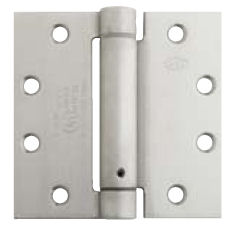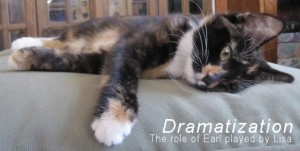 After my post about the Parkside West fire, a couple of people have asked me what I have against spring hinges. I’m not one to discriminate against hardware of any function, style, or finish, but I also like things to do what they’re supposed to do. If I could get my kids to act more like cast iron door closers, I’d be a happy camper. I’m not picking on spring hinges here – Ives makes spring hinges and is also one of the brands that keeps a roof over my head. They just need to be used for the right applications.
After my post about the Parkside West fire, a couple of people have asked me what I have against spring hinges. I’m not one to discriminate against hardware of any function, style, or finish, but I also like things to do what they’re supposed to do. If I could get my kids to act more like cast iron door closers, I’d be a happy camper. I’m not picking on spring hinges here – Ives makes spring hinges and is also one of the brands that keeps a roof over my head. They just need to be used for the right applications.
The term “spring hinge” is pretty self-explanatory. It’s a hinge which incorporates a spring, theoretically to close the door. The advantages of spring hinges are 1) they look (to the untrained eye) like a hinge…no “unsightly” door closer to incorporate into the design, and 2) they’re inexpensive. They cost more than a regular hinge, but less than hinges + a door closer. The accessibility standards and NFPA 80 (with door size limitations) allow spring hinges, so given the low cost and aesthetic advantages, they’re pretty popular for certain applications.
The most common application for spring hinges is a dwelling unit (apartment, hotel room) entry door. Budgeting a door closer for each hotel room can really add up, and some architects object to the look of a door closer on a door that is meant to look more residential. I have seen spring hinges on other doors – once even in a stairwell (:-0) but my guess is that the limitations of spring hinges have relegated them to use mostly on dwelling units which have a lower usage and perceived lower risk than some other doors.
 About 20 years ago I went to AH2 – level 2 of the architectural hardware course DHI offered (I’ll have to dig up my class photo and post it!). My instructor called spring hinges “cat killers” and even had a flat cat named Earl that he used as a visual reminder. Door closers control a door with a combination of spring power, hydraulic fluid, and adjustment valves (prefurred by the United Brotherhood of Cats). Spring hinges need to get some momentum going and work like heck to overcome any resistance they encounter during the closing cycle, whether it’s from air pressure, the latching mechanism, door bind, gasketing, or something else.
About 20 years ago I went to AH2 – level 2 of the architectural hardware course DHI offered (I’ll have to dig up my class photo and post it!). My instructor called spring hinges “cat killers” and even had a flat cat named Earl that he used as a visual reminder. Door closers control a door with a combination of spring power, hydraulic fluid, and adjustment valves (prefurred by the United Brotherhood of Cats). Spring hinges need to get some momentum going and work like heck to overcome any resistance they encounter during the closing cycle, whether it’s from air pressure, the latching mechanism, door bind, gasketing, or something else.
After a while, spring hinges tend to lose power, and sometimes need to be adjusted so they still have enough force to close the door. Unfortunately, they’re rarely adjusted after the initial installation. This makes spring hinges unreliable – they might get the door almost to the closed position, but not latched. If it’s a fire door, the door is no longer code-compliant, and the smokeseal that’s now required on many fire doors can create more resistance for the spring hinges to overcome. If it’s a door on an accessible route, the lack of control and the high rate of closing speed can be inconvenient or worse. One of our specwriters was called to a job-site because the light bulbs in the corridor wall sconces were blowing out repeatedly. It turned out that the slamming of the doors with spring hinges was the cause.
Spring hinges do have their place. Just today one of our specwriters was asking about a small access door that covered an alcove for an automatic sliding fire door – perfect! A fire-rated unequal-leaf pair with a 1′ leaf or a rarely-used mechanical room might be good applications. But the use of spring hinges should be very carefully considered. There are small but durable door closers that are not expensive, can be finished to match the door and frame, and would do a much better job of closing, and controlling the door.
You need to login or register to bookmark/favorite this content.






hello lori, a great post here on cat traps (ok, spring hinges) i once caught the dog’s tail on the storm door (just a regular extension spring, no closer installed) ya, its not that pleasent for the animal more less a person to get a finger caught or tail in a spring hinge (snap shut closer) controlled door.
as for you wishing the kids would act like cast iron closers, tell them to close the door like it’s made of an expensive glass (fragile) or if that doesn’t work, tell them you have a TERRIBLE headache/migraine and it hurts your head badly when they slam the door.
if all else fails (not sure if your house doors are solid or hollow core doors) go to a hardware store or from LCN a few arm type closers for household doors.
I was younger (elementary to middle school age) it was RIGHT THE OPPOSITE, I would FORGET to close the door, I call this the “door closer phenomenon”, because when a person gets used to the doors shutting by themselves then go home (from school or from the place that has closers) they are soo used to the automatic doors that they don’t transition back as fast to the old manual way of things (no closers or automatic doors)
now for cat owners, (laughing a little because of a technical school teacher’s reaction to an LCN closer “hissing” while closing) lets just say, reminded him of a ticked off cat and he pretty much jumped out of his skin! (in reaction to the hissing noise obviously from the shop exit door closer)
-Jess
Hi
I like your comments here on spring hinges.
My question: can spring hinges be used on a 90min fire-rated mechanical door?? I know that we can
use them on 20min door (apartment entrances and hotel rooms).
Thanks for your reply.
You can use spring hinges on a 90-minute door as long as it’s not larger than 3′ x 7′. Just keep in mind that the hinges will require adjustment over time to keep the door self-closing. I think an inexpensive closer is a more reliable choice without a huge investment, but there’s nothing in the codes that would prevent the use of spring hinges in this application.
Thank you for taking the time for sharing this blog. I have acquired a lot of knowledge from your blog and have already bookmarked it and will definitely share with my colleagues. Keep Blogging!
Hi Lori
I had a question about the spring hinge. What is the meaning NFPA said “Spring hinge should be labeled”? If the spring hinge only tested ANSI/BHMA A156.17 in UL but without UL10c fire test the spring hinge. Can such spring hinge used in UL10c fire door/access panels?
Or the spring with both UL10c and ANSI/BHMA A156.17. Then it can be used in UL10c fire door? Of course it also follow NFPA 80’s Table 6.4.3.1 Builders Hardware: Hinges, Spring Hinges, and Pivots
Hi Terry –
Most components of a fire door assembly are required to be labeled. The term “labeled” is defined by NFPA 80 as: Equipment or materials to which has been attached a label, symbol, or other identifying mark of an organization that is acceptable to the authority having jurisdiction and concerned with product evaluation, that maintains periodic inspection of production of labeled equipment or materials, and by whose labeling the manufacturer indicates compliance with appropriate standards or performance in a
specified manner.
Many types of hinges are not required to be labeled because they are considered generic, but spring hinges do need to be labeled as defined above. You mentioned spring hinges that are tested to the BHMA standard but not to UL 10C – those would not be compliant with the requirements of NFPA 80.
– Lori
Hi Lori
Thanks for your reply. So, Spring hinge used in UL10c door that should have UL10c test and ANSI/BHMA A156.17 test? Can you recommend which Allegion spring hinge can used in my UL10c fire door that is compliant with the requirements of NFPA80?
The model codes don’t require compliance with the BHMA standard for hinges. Ives 3SP1 spring hinges are listed for use on fire door assemblies. They are on page A9 of this catalog: https://us.allegion.com/content/dam/allegion-us-2/web-documents-2/Catalog/IVES_Architectural_Hardware_Products_Catalog_105313.pdf.
– Lori
[…] Spring Hinges […]